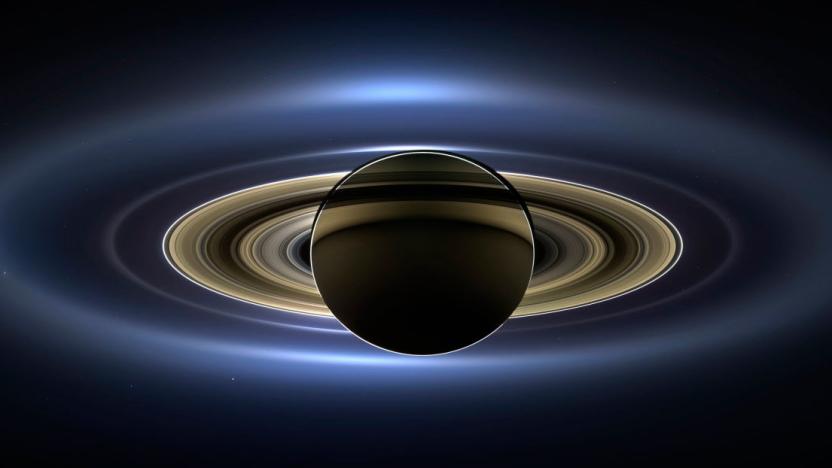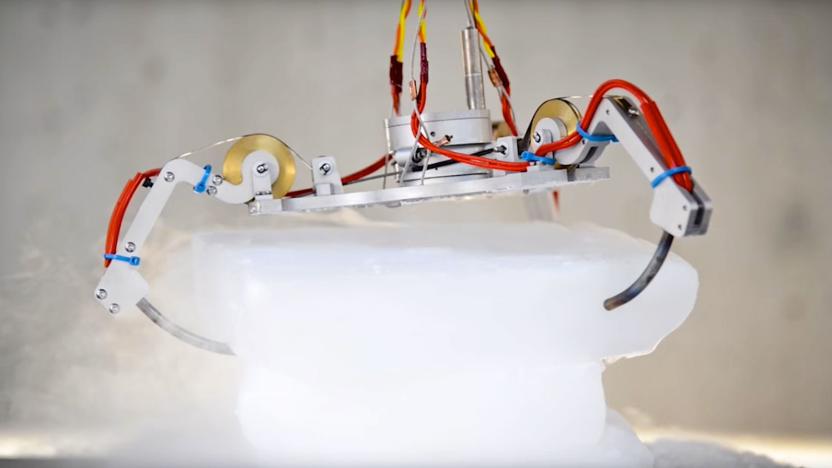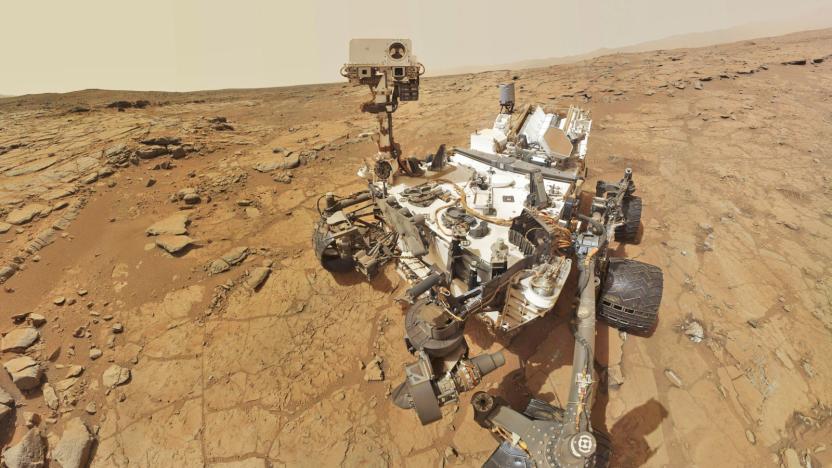mars rover
Latest

Recommended Reading: The fear of TikTok
It's unclear what the White House will actually do at this point. Why does everyone seem to be afraid of the app that houses silly dance and lip-sync videos? The Atlantic explains how we got here and why a full-on ban probably isn't the best idea.

Second failure of ExoMars parachute test throws schedule in jeopardy
A joint mission between the European and Russian space agencies to deliver a rover to Mars is facing another setback. The European Space Agency (ESA) confirmed that parachutes for the ExoMars lander mission failed a second test that was conducted last week. A similar trial conducted back in May on the same parachutes also ended up malfunctioning. Scientists observed damages in the canopy in both cases.

Help NASA name its Mars 2020 rover
NASA's Mars 2020 rover is beginning to take shape. Earlier this month, crews installed some of its legs and six of its wheels. Now, the vehicle needs a name, and for that, NASA is turning to students. Beginning in fall 2019, NASA will run a nationwide "Name the Rover" contest open to K-12 students in the US. The spacecraft will need a name by July 2020, when it's expected to launch.

A lawsuit almost stalled NASA's Cassini mission
Capt. Scott Kelly wasn't kidding when he famously quipped that "space is hard." Even getting to the launch pad can prove to be a daunting challenge. Take the Cassini mission to study Saturn, for example. Despite an investment of $3.4 billion and nearly a decade of development, Cassini wound up being very nearly scuttled at the last minute by protesters who thought they knew better than a federal agency that has put multiple men on the moon. Geez guys, it was just 73 pounds of plutonium riding aboard that Saturn orbiter -- it wouldn't have caused that much damage had something gone horribly wrong at launch.

How NASA's future robots will explore frozen worlds
Delivering a rover to the surface of a distant icy world like Jupiter's moons Europa and Titan is only half the challenge. Once on the surface, the robotic explorers will have to contend with intense space radiation, plunging temperatures that drop to hundreds of degrees below zero and miles upon miles of ice before hitting the subsurface oceans that astronomers suggest may contain life. But NASA has a plan.

Curiosity rover can shoot lasers at any rock it wants
Is there anything cooler than sending a robot to Mars to shoot rocks with lasers? Probably not -- which is why NASA is giving the Curiosity rover the ability to shoot even more rocks with lasers. Okay, technically NASA is giving the Martian rover the ability to choose targets for ChemCam analysis. This is a process that uses a laser and telescopic camera to sort out the chemical composition of Martian rocks. Typically, NASA chooses the targets manually, but a new update will allow the rover to collect data autonomously.

NASA sidelines its next Mars Rover mission indefinitely
NASA announced on Tuesday that it has cancelled the upcoming March, 2016 launch of its next Mars Rover, the InSight mission, after realizing it would be unable to fix a busted, French-built seismological instrument in time for liftoff. Unfortunately, due to the relative orbits of Earth and Mars, we won't have another suitable launch window for at least 26 months after that -- aka, May 2018.

Colin Pillinger, Britain's Mars-rover chief, dies aged 70
Colin Pillinger, one of Britain's most famous space scientists, has died at the age of 70 from a brain hemorrhage. Professor Pillinger was the very definition of a plucky Brit, whose force of personality and optimism enabled him to oversee construction of the Beagle-2 Mars probe. Despite overwhelming odds, the academic convinced the European Space Agency to convey the device on the back of one of its rockets. Unfortunately, contact was never made with the probe, and it is believed to have crashed trying to land on the Red planet. Despite this, Pillinger was able to raise the profile of the British space program and bring together the nation's various industrial and technical communities.

Welcome to Mars on Earth
We already know the radiation levels on Mars' surface are safe enough for us to go ahead and start building vacation homes. But, before we can finish our plans for the pool, there are still a few more tests that need to be done. There's just one problem: the planet has a way of destroying all of the scientific equipment we send to check it out. (If we're pointing fingers, mostly because of the magnetized dust on its surface.) Rather than send another rover to be demolished far away from home, Madrid's Center for Astrobiology thinks they've created a way to test out every robotic arm and camera while they're still on Earth using a device called MARTE.

Curiosity rover drills into Martian rock, looks for more evidence of water
NASA scientists won't have to wait until InSight's 2016 drilling mission to see what lies beneath the surface of Mars -- Curiosity is already on the case. After developing a taste for Martian soil late last year, the intrepid rover has started exploring the red planet's bedrock, drilling a 0.63 inch (1.6 cm) wide hole 2.5 inches (6.4 cm) deep into Mars' surface. Curiosity will spend the next several days analyzing the resulting powder in hopes of finding evidence of a once-wet planet. The shallow hole marks the first drilling operation ever carried out on Mars, and getting there wasn't easy. "Building a tool to interact forcefully with unpredictable rocks on Mars required an ambitious development and testing program," explained Louise Jandura, the chief engineer of the rover's sample system. "To get to the point of making this hole in a rock on Mars we made eight drills and bored more than 1,200 holes in 20 types of rock on Earth." The Rover tested its drill by creating a shallower hole earlier this month, though samples will only be used from the second, deeper cavity. Check out the source link for more images of the operation, including an animated GIF of the drill in action.

NASA's Curiosity rover finds ancient streambed on Mars, evidence of 'vigorous' water flow
Curiosity may have spent a while limbering up for the mission ahead, but now it's found evidence of an ancient streambed on Mars that once had "vigorous" water flow. Photos of two rock outcroppings taken by the rover's mast camera between the north rim of Gale Crater and the foot of Mount Sharp reveal gravel embedded into a layer of conglomerate rock. The shape of the small stones indicate to NASA JPL scientists that they were previously moved, and their size (think from grains of sand to golf balls) are a telltale sign that water did the work instead of wind. Evidence of H2O on Mars has been spotted before, but this is the first direct look at the composition of riverbeds NASA has observed from above. According to Curiosity science co-investigator William Dietrich, it's estimated that water flowed at the site anywhere from thousands to millions of years ago, moved at a clip of roughly 3 feet per second and was somewhere between ankle and hip deep. "A long-flowing stream can be a habitable environment," Mars Science Laboratory Project Scientist John Grotzinger said. "It is not our top choice as an environment for preservation of organics, though. We're still going to Mount Sharp, but this is insurance that we have already found our first potentially habitable environment."

Curiosity rover starts light robotic arm workout in preparation for scientific main event
As NASA promised, Curiosity has stopped at the quarter pole toward its first scientific destination to test its robotic arm and attached scientific instruments. After 100 yards of driving, the rover extended its 7-foot limb, and will now spend six to ten days checking its predetermined positions and range of motion. That will ensure the appendage is ready after surviving the chilly vaccuum of space and subsequent setdown, and will let its minders see how it functions in the unfamiliar Martian gravity and temperatures. The JPL scientists in charge of the six-wheeler will also peep the Mars Hand Lens Imager and made-in-Canada Alpha Particle X-Ray Spectrometer to warrant that they're up for all the geology to come. If all goes well, the rover will start scooping, drilling and analyzing in earnest when it hits Glenelg, then Mount Sharp -- so, we'd limber up first before tackling all that, too.

Mars Curiosity leaves its landing area, heads to distant frontier a quarter-mile away
Now that Curiosity has survived its thrill-a-minute landing and passed an upgrade and physical with (nearly) flying colors, the rover is off to earn its $2 billion keep. The trip started well, with the buggy driving 52 feet towards its first science site "beautifully, just as our rover planners designed it," according to NASA. The destination, Glenelg, is 1,500 feet away from the now-familiar Bradbury Landing where it first set down, which is pretty far for a rover that treks along at about a tenth of a mile per hour. On top of that, its minders have some stops in mind to test instruments -- meaning it'll arrive there in about two weeks. Once at Glenelg, Curiosity will scope the unusual geology of the region, though its principal destination for science is Mount Sharp, a relatively vast six miles away. Don't worry about it running out of gas, though -- the nuclear power supply will last a full Martian year, or 687 earth days.

Voice signals sent to Mars and back, while telephoto images tease rich geology
The Martian hills are alive with the sound of music. Well, NASA Administrator Charles Bolden's voice at least, as the agency reveals that the first recorded human voice has traveled from Earth, to another planet, and back. The words might not have literally echoed in the surrounding hills, but by having been beamed to Curiosity and back again, have made a small step towards interplanetary communication. Along with the motivational words of Bolden, the rover returned some telephoto images from the onboard 100mm and 34mm lenses. The pictures show the hills toward which Curiosity is bound, and tease the scientists with their rich-looking -- and hopefully revealing -- layers of geology. Want to know what interplanetary voicemail sounds like? No need to go to Mars and back, just click on the more coverage link below.

Angry Birds Space hijacks NASA's Curiosity Mars Rover this fall
A new update for Angry Birds Space adds twenty levels focused on the Red Planet and all the recent activity surrounding NASA's Mars Rover, Curiosity. Players will find a new Astronaut Pig to knock around, along with three hidden rovers and landers to discover that once found will unlock "special bonus levels."The Red Planet update for Angry Birds Space is coming this fall. Rovio hasn't said anything about pricing, but we expect this content won't be free – even if the last update was.

Curiosity rover flaunts its battle scar, wind sensor is bruised (but not broken)
You can't win 'em all. Such is the case with the Curiosity rover, anyway, as diagnostics have revealed that its wind sensors have sustained damage. NASA engineers aren't fully sure what caused this minor setback to the otherwise successful landing, but hypothesize that stones might've been kicked up during the rocket-powered landing, which then struck the sensor's wiring. Fortunately, there's already someone on the job, as Javier Gomez-Elvira is investigating the damage with the intent of restoring the lost functionality. Another NASA scientist, Ashwin Vasavada, believes the issue is rather minor: "It degrades our ability to detect wind speed and direction when the wind is blowing from a particular direction, but we think we can work around that." The broken instrument was initially discovered as part of NASA's routine power-cycling of all instrumentation, so as to determine an overall bill of health for the rover. Now that Curiosity has earned its battle scars, it can hold its head high during its journey to Glenelg and Mount Sharp.

Curiosity landing video assembled from high-res images (video)
A new video has been compiled by Spaceflight101.com showing Curiosity's final minutes of terror in glorious HD (though a dearth of frames and lack of stabilization make it a bit herky-jerky). It's an assembly of all the high-res photos taken by the buggy on the way down to its now familiar perch, rolling at the not-exactly-HFR speed of 4 fps, but still trumping a previous low-res thumbnail version. It gives a much clearer, rover's-eye-view of the journey, starting with the heat shield ejection and finishing with the dusty, butterfly-like touchdown. Check it out below the break to see the precarious descent -- and don't forget your Dramamine. Update: An enterprising (and patient) individual, Dominic Muller, spent four straight days creating a frame interpolated version of the video, giving the choppy footage a beautiful, smooth new look. Check out his version below the original after the break -- blow it up to full screen HD, crank the sound and enjoy.

NASA maps out proposed travel plans for Curiosity, decides to head for the hills
As the vista on Mars gradually gets ever clearer, and the system checks continue to show that the rover is in good stead, the team behind Curiosity will be increasingly eager to stretch its legs wheels. The first trip might be just a cautious few meters, but plans for a more adventurous jaunt have just been revealed. The first location in Curiosity's sights is an area referred to as Glenelg, which, based on initial pictures, offers three different geological characteristics, as well as potentially being an area where water used to be present. The site is only 1,300 feet (400 meters) from where the rover landed, but it could still take several weeks to get there. This is merely a quick dash compared to the next leg of its journey, which sees Curiosity heading out to an area called Mount Sharp -- a large mound of layered rock which is hoped to contain visible geology potentially dating back millions of years. With seven kilometers (4.4 miles) lying between the rover and the mountain's foothills, it'll be a much longer journey, but one that could provide the first real evidence of the planet's ability to host, or have hosted, life.

Curiosity survives brain transplant, prepares for first drive
If you thought your OTA update took too long, how about four days? That's how long the Curiosity "brain transplant" took, and is now finally complete. This now means that the main computers have switched over from landing mode, to surface mode -- and thus we hope -- meaning the rover's good to go. That said, it's still a painfully slow process, with Curiosity's wheels likely remaining steadfastly motionless for at least another week -- and even then we're looking at a trip of just a few meters. When it comes to interplanetary travel, though, slow and steady definitely wins the race -- in the meantime, you can soak up the view.

Life on Mars: One week of Curiosity
Is there life on Mars? NASA's latest mission to the red planet might well answer that question, or perhaps the more pertinent question, was there life on Mars. At 10:02 AM EST on November 26th last year, the space agency's Mars Science Laboratory (to give the mission its full name) set off on its eight-month journey to the red planet. The most advanced equipment ever sent to the planet -- and the biggest-ever rover -- should allow exploration of some of the most interesting regions, over far larger distances than ever previously covered. On arrival, after negotiating a tricky landing, the mobile laboratory (that's Curiosity) will spend a Martian year (687 Earth days) analyzing rock samples and seeking evidence of conditions suitable for microbial life or -- we can live in hope -- actual evidence of the same. After the break, we take a look at some of the key events over the first seven days on the planet's surface.











